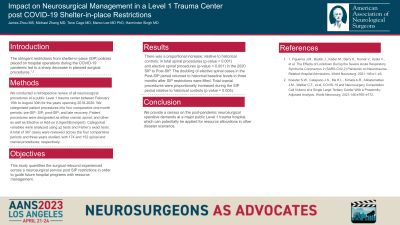Impact on Neurosurgical Management in a Level 1 Trauma Center post COVID-19 Shelter-in-place Restrictions
Impact on Neurosurgical Management in a Level 1 Trauma Center Post COVID-19 Shelter-in-place Restrictions
Friday, April 21, 2023


James Zhou, MS
Medical Student
California Northstate University
Elk Grove, California, United States
ePoster Presenter(s)
Introduction: The stringent restrictions from shelter-in-place (SIP) policies placed on hospital operations during the COVID-19 pandemic led to a sharp decrease in planned surgical procedures. This study quantifies the surgical rebound experienced across a neurosurgical service post SIP restrictions in order to guide future hospital programs with resource management.
Methods: We conducted a retrospective review of all neurosurgical procedures at a public Level 1 trauma center between February 15th to August 30th for the years spanning 2018-2020. We categorized patient procedures into four comparative one-month periods: pre-SIP; SIP; post-SIP; and late recovery. Patient procedures were designated as either cranial; spinal; and other; as well as Elective or Add-on (Urgent/Emergent). Categorical variables were analyzed using χ2 tests and Fisher’s exact tests. A total of 347 cases were reviewed across the four comparative periods and three years studied; with 174 and 152 spinal and cranial procedures; respectively.
Results: There was a proportional increase; relative to historical controls; in total spinal procedures (p-value < 0.001) and elective spinal procedures (p-value < 0.001) in the 2020 SIP to Post-SIP. The doubling of elective spinal cases in the Post-SIP period returned to historical baseline levels in three months after SIP restrictions were lifted. Total cranial procedures were proportionally increased during the SIP period relative to historical controls (p-value = 0.005).
Conclusion : We provide a census on the post-pandemic neurosurgical operative demands at a major public Level 1 trauma hospital, which can potentially be applied for resource allocations in other disaster scenarios.
Methods: We conducted a retrospective review of all neurosurgical procedures at a public Level 1 trauma center between February 15th to August 30th for the years spanning 2018-2020. We categorized patient procedures into four comparative one-month periods: pre-SIP; SIP; post-SIP; and late recovery. Patient procedures were designated as either cranial; spinal; and other; as well as Elective or Add-on (Urgent/Emergent). Categorical variables were analyzed using χ2 tests and Fisher’s exact tests. A total of 347 cases were reviewed across the four comparative periods and three years studied; with 174 and 152 spinal and cranial procedures; respectively.
Results: There was a proportional increase; relative to historical controls; in total spinal procedures (p-value < 0.001) and elective spinal procedures (p-value < 0.001) in the 2020 SIP to Post-SIP. The doubling of elective spinal cases in the Post-SIP period returned to historical baseline levels in three months after SIP restrictions were lifted. Total cranial procedures were proportionally increased during the SIP period relative to historical controls (p-value = 0.005).
Conclusion : We provide a census on the post-pandemic neurosurgical operative demands at a major public Level 1 trauma hospital, which can potentially be applied for resource allocations in other disaster scenarios.
